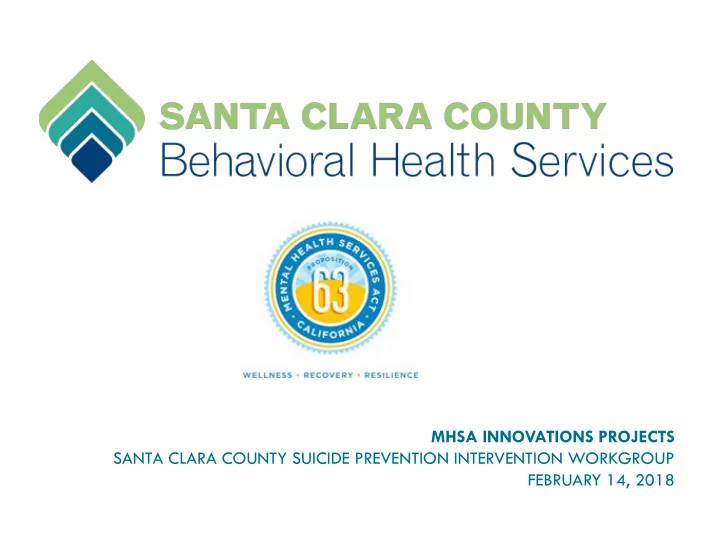

MHSA INNOVATIONS PROJECTS SANTA CLARA COUNTY SUICIDE PREVENTION INTERVENTION WORKGROUP FEBRUARY 14, 2018
MHSA INNOVATION (INN) Innovation projects are designed to: -Increase access to underserved groups -Increase the quality of services, including better outcomes -Promote interagency collaboration -Increase access to services
POPULATION SERVED Children Transitional Aged Youth (TAY) Adults Older adults Families (self-defined) Neighborhoods Tribal and other communities Counties, multiple counties, or regions
FAITH BASED TRAINING AND SUPPORTS • Initiated by faith community leaders among the Santa Clara County Faith Based Collaborative • Community-led selection of Project Coordinators from diverse communities • Form a cohort of faith spiritual leaders and behavioral health direct care providers as an advisory group • Design and implement customized faith-based behavioral health training for faith community leaders • Design and implement faith-informed workshop series for behavioral health direct care providers to learn about spirituality and faith in assisting faith communities • Amount: $608,964; Project Length: 24 months
LEARNING GOALS • Does a comprehensive faith-based behavioral health training improve faith community leaders’ knowledge, attitudes and behavior in the identification, support and referral of individuals with behavioral health conditions? • To what extent is stigma reduced among faith communities participating in faith-based trainings? • How does a faith-based training workshop series impact behavioral health direct care providers’ work with clients/consumers?
CLIENT AND CONSUMER EMPLOYMENT • Adopt Individual Placement & Support Supported Employment (IPS/SE) model • Transform how the overall system embraces employment and normalizes employment • Shift from a discreet program to a critical component of recovery and an element of treatment • Amount: $2,525,148; Project Length: 36 months
LEARNING GOALS To what extent does the new employment approach impact those in the County system who are currently unemployed in the following measures: Percentage of program participants who participate in IPS/SE Percentage of program participants with identified employment goals Average number of hours worked per week Total hours worked during the year Total earnings during the year Total months employed What are the overall outcomes identified by Santa Clara County clients/consumers participating in IPS/SE?
ADDRESSING CRISIS AND POST CRISIS NEEDS • A recent study conducted by the Centers for Disease Control and Prevention (CDC) in Santa Clara County found: • Hospitalizations for suicide attempt/self ‐ injury increased from 2004 to 2014 • Emergency Department visit rates for both Palo Alto/Stanford and for Morgan Hill are both higher than the rates for Santa Clara County overall • 62% of suicides among 10-24 year olds in Santa Clara County occurred in ages 20-24 • 29% had prior suicide attempts • Suicide is the second leading cause of death among 18 – 24 year olds Source: https://www.sccgov.org/sites/phd/hi/hd/epi-aid/Pages/epi-aid.aspx
PSYCHIATRIC EMERGENCY RESPONSE TEAM (PERT) AND PEER LINKAGE • Pilot two county-operated teams in first 6 months in partnership with City of Palo Alto Police Department and Santa Clara County Sherriff’s Office • Roll out at least two additional teams in Santa Clara County • Provide post-crisis services specifically for ages 18-25 through a peer support network • Partner with local jurisdictions on PERT • Amount: $3,688,511 Project Length: 24 months
LEARNING GOALS In addition to feasibility checks and tracking all project activities, client/consumer outcome impact will be prioritized to address the following learning goals: Can the measures show improved outcomes for youth participating in peer linkage project and how does this support increase help-seeking behavior? Can comparisons with existing stand alone CIT efforts with PERT model show benefits of a combined approach? To what extent does SCC PERT improve law enforcement attitudes and abilities to safely respond to mental health related calls, link people to mental health services, and possibly reduce the number of persons with mental illnesses entering the front door of the criminal justice system?
HEADSPACE • Adapt and replicate the headspace model – a “one stop shop” integrated health and mental health care by physicians, on-site psychiatric services, alcohol and drug treatment, educational and employment services for youth ages 12-25 • A community-driven approach that has been successful in a national health insurance model • A 2015 headspace feasibility study concluded that there is clear value in developing this model in the US, since currently there is no similar public mental health early intervention structure in place for young people in the US Source: Adelsheim, S., Tanti, C., Harrison, V., and King, R., (2015). headspace: US Feasibility Report.
HEADSPACE : RAMP UP • Recruit and maintain youth advocacy councils (for up to two sites) • Build Supported Employment and Education Specialist to ensure comprehensive youth-engaged services • Find turn-key center locations in high youth density areas and commuter access corridors • Build implementation and evaluation infrastructures • Create a new model for public/private billing, thus providing a new service model for other counties and states • BHSD will return in Spring 2018 with a headspace framework for funding to cover up to four years of implementation • Amount: $572,273, Ramp up Phase: 8 months
LEARNING GOALS • The learning goals of the Ramp Up Phase are focused on the BHSD-Stanford Team collaboration in designing a comprehensive, data collection system and a plan to systematically capture information from both private and public sector services • Infrastructure and sustainability analysis would include: • Service activity • Client profile • Program/service outcomes/effectiveness • Program/service awareness • Services integration • Increased accessibility for marginalized youth clients • Cost/financial sustainability
Comments & Questions
THANK YOU Evelyn Tirumalai , MPH MHSA Coordinator Lily Vu , MSW MHSA Innovations Coordinator
Recommend
More recommend